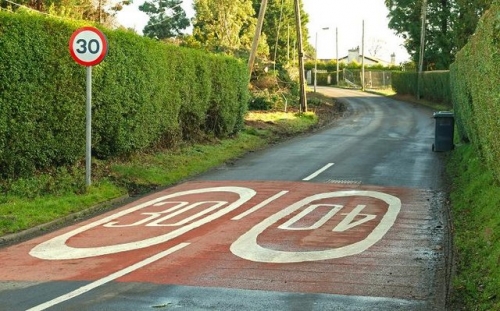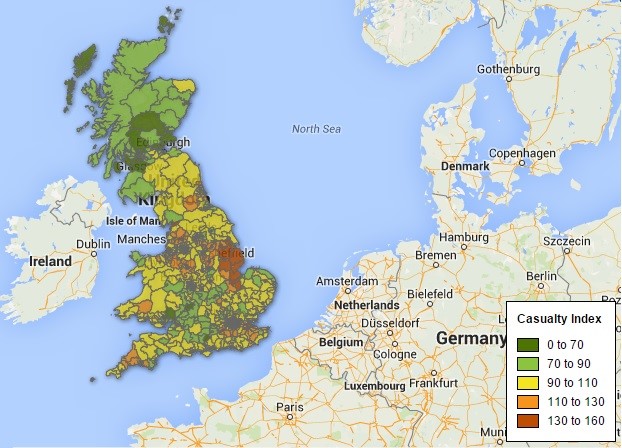
With the most unpredictable election in years almost upon us, people across the UK are looking to their local MPs and asking what they are going to do about the issues important to them. And one important issue that is on a lot of people’s minds, as well as their MP’s, is the subject of road safety across the UK, and that is not surprising. In 2013, a total of 183,670 people were injured on roads in the UK. 23,370 of those were seriously injured or killed.
The Parliamentary Advisory Council for Transport Safety (PACTS) has published a manifesto to urge the next government to commit to road safety and is encouraging all MPs running to include measures to improve road safety into their political campaigns. According to PACTS, accidents on the road are the number one cause of death amongst young people in the UK and are the biggest danger people face when going about their day-to-day lives.
If that wasn’t enough to encourage those hoping to gain a seat in Parliament on 7th May to make road safety a top priority, PACTS recently published a Road Safety Dashboard in the hope that it will allow MPs to get a clearer picture of the severity of road traffic accidents in their constituencies. By providing specific information on the number of casualties in each area, PACTS hopes to encourage local people to get involved with improving road safety in their community. Upon the launch of the Dashboard, Executive Director of PACTS, David Davies, spoke of how he believed MPs can act as inspirations to those in their constituency by championing road safety in Parliament, where the biggest changes can be made.
In the run up to the General Election in May, many MPs have already declared their commitment to road safety by supporting campaigns such as National Road Safety Week, and by calling on their fellow MPs for change.
The country’s most dangerous roads
Using data gathered by the Department for Transport between 2008 and 2013, the Dashboard allows anyone to access road traffic accident analysis for their area where the data has been broken down into individual categories such as casualty severity, road user groups and age. The whole of the UK has been broken down by constituency rather than the actual location of collisions, and has been colour coded according to the casualty rate. Green shows a relatively low rate of casualties, whilst brown indicates a high number.

According to the statistics and the data shown on the map, Lincolnshire is home to some of the most dangerous roads in England, with the town of Great Grimsby having the highest casualty rate at 52% above the national average. However, Lincolnshire was not the highest. The constituency of Banff and Buchan, located in the North East of Scotland, had a casualty rate 111% above the national average, which means that residents are twice as likely to be seriously injured or killed on the roads.
It is believed that rural areas will be the worst when it comes to road casualty rates due to country roads having higher speed limits and fewer measures in place for calming traffic, which can lead to high-speed impact collisions. On the other hand, the roads of small cities and large towns appear to be safer, such as Bath, which had a casualty rate that was 51% below the national average, mostly likely due to increased traffic, lower speed limits and more prominent traffic controls.
What can be done to improve road safety?
According to the PACTS report, there are three contributing factors to serious injuries and deaths from road traffic accidents. Driver behaviour, which includes driving above the speed limit, driving under the influence of drugs or alcohol, using a mobile phone whilst driving and not wearing a seatbelt. The second is the quality of road, and the vehicles that travel on it. And finally, the quality and responsiveness of emergency medical care in that constituency.
One of the main preventative measures that needs to be taken in order to reduce casualties on the roads is the education of drivers on how they can do their bit to keep themselves and other road users safe. Research conducted by the Department for Transport in 2014 found that 1.6% of people in England and Scotland had been observed using a mobile phone in moving traffic. The same research discovered that 1.8% of people didn’t wear seat belts whilst driving.
There have been recent proposals to overhaul the current UK driving test system, which would see those learning to drive tested on their ability to cope with driving at night, in poor weather conditions or on country roads, which are often poorly lit, narrow and have high speed limits. Another change would see new drivers put through a second test a year after their original one to ensure that their skills are up to scratch.
With the quality of the vehicles on the road being an important factor in the number of road accidents, some car companies have taken it upon themselves to do their bit to keep people safer. In late 2014, Ford announced that it would be adding pedestrian detection technology to its vehicles. Debuting on the Ford Mondeo European model in 2015, the ‘Pre-Collision Assist with Pedestrian Detection’ feature scans the road ahead and will give drivers a collision warning when it detects the risk of a vehicle or pedestrian crash. If the driver fails to respond in time, then the vehicle’s brakes will be applied automatically. This feature joins other driver-assist technologies developed by Ford, such as their Blind Spot Information System, active park assist and lane-keeping systems.
Ford has also participated in the test of an “early warning” brake light, which will signal to the driver behind that the car is about to brake in anticipation of a bend or if approaching traffic. The study discovered that the extra warning time allows drivers behind to brake earlier and thus avoiding a potentially serious collision.
The future of road safety
The government have already started cracking down on road safety. As of 2nd March 2015, changes to the Drug Driving Law made it easier for police officers to catch and prosecute those who drive under the influence of drugs. THINK!’s recent campaign highlighting the effects drugs can have on your system, and how they make it easy for police to spot you, is a huge step forward in educating the public about safe driving.
But there is no doubt that further progress needs to be made if the UK’s roads are to be made safer in the future. Educating the public further on the dangers of being distracted from the road, such as through using mobile phones, and on the consequences of speeding will need to be provided by the government as the car itself can only do so much to prevent road users from getting hurt.
While safety is the most pressing issue, as insurance consultants it would also be nice to see if a downturn in road collisions will ultimately result in lower premiums across the board. Whether or not you have a no-claims history, we can help you find a cheap quote. Click here to see how much you can save.
Comments
Go to blog index
